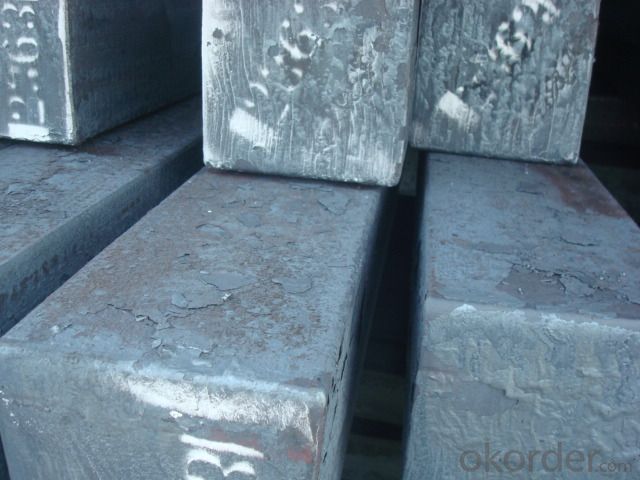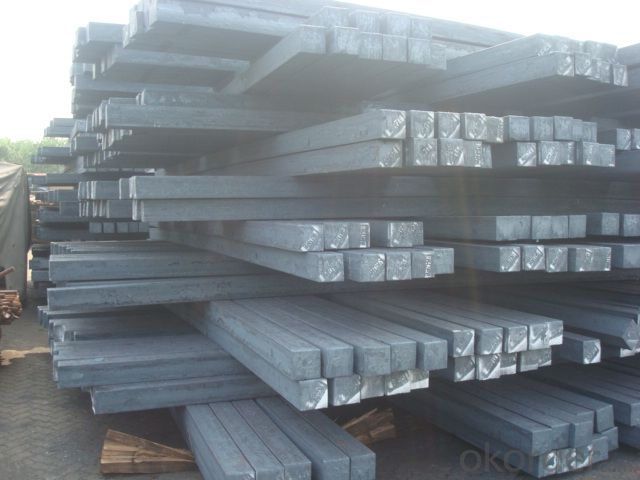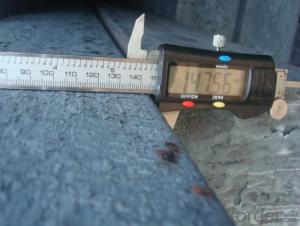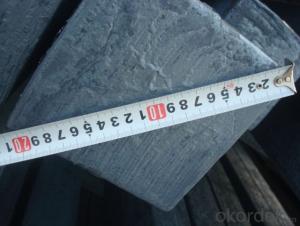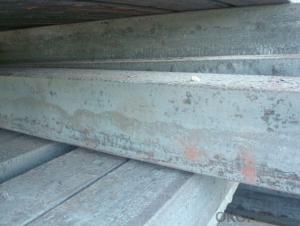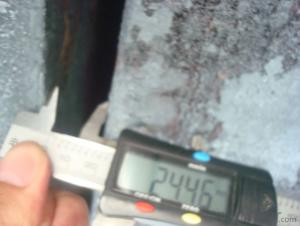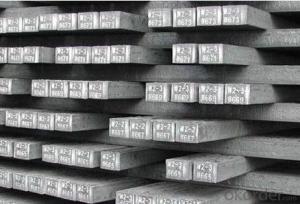Steel Bloom Manufactured by Big Blast Furnace
- Loading Port:
- Tianjin
- Payment Terms:
- TT OR LC
- Min Order Qty:
- 1000 m.t.
- Supply Capability:
- 100000 m.t./month
OKorder Service Pledge
OKorder Financial Service
You Might Also Like
Steel Bloom Manufactured by Big Blast Furnace
1.Structure of Steel Bloom Manufactured by Big Blast Furnace
Steel Bloom Manufactured by Big Blast Furnace is the raw material of all kinds of steel mill. Billet section of square, round, flat, rectangular and abnormity, etc Several, mainly related to shape of rolled products. Simple rolled section steel, choose cross section of square billet or rectangular billet. rolling The sector products such as flat steel, Angle steel, select the rectangular billet or slab. Had better profiled billet when production beams, channels, and in rolling process Lines and improve the yield. The raw material of round billet is the production of seamless tube.
2.Main Features of Steel Bloom Manufactured by Big Blast Furnace
Steel Bloom Manufactured by Big Blast Furnace section size should meet the requirements of rolling deformation and finished product quality, but also roll strength and biting condition of restrictions. General steel Billet section height H. And the roll diameter D The ratio of the ( namely H/D) Should be less than or equal to zero 0.5 . Length of steel billet by finishing temperature, Rolling time and the length of the product Or times ruler. When heated too long accident prone to bump the furnace wall of steel, too short, furnace bottom utilization rate is not high, influence the heating furnace production. For the production Choose a variety of steel and steel billet, should consider the affinities of billet, as far as possible in order to improve the productivity of the roughing mill, simplify the stock management of workshop.
3. Steel Bloom Manufactured by Big Blast Furnace Images

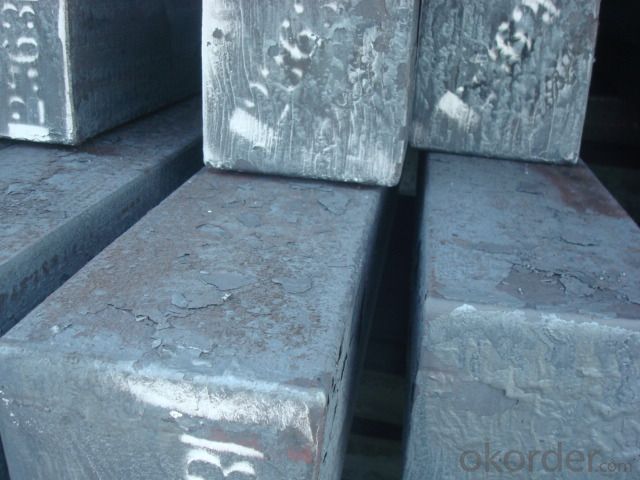
4. Steel Bloom Manufactured by Big Blast FurnaceSpecification
Steel Billet Manufactured by Blast Furnace rolled steel, after processing can be used for mechanical parts, forging parts, processing all kinds of steel, steel Q345B channel steel, wire rod is the role of the billet. Steel billet is used in the production of semi-finished products, generally cannot be used directly for the society. Steel billets and steel are strictly divided into standard, cannot decide to whether the business enterprise of the final product, and according to unified standards to perform the whole society. Typically, billet and the steel is relatively easy to distinguish, but for some steel billet, and have the same specification and same steel purposes (such as rolling tube billet), whether can be used for other industries, whether through steel processing process, whether through a finished product rolling mill processing to distinguish
Material standard The editor Range of thickness: 150-240 - mm + / - 5 mm width range: 880-1530 - mm + / - 20 mm Length: 3700-10000 - mm + / - 500 - mm Cross-sectional size: 64 * 64; 82 * 82; 98 * 98; 124 * 124; 120 * 150; 152 * 164; 152 * 170 mm Length: 9000 mm Section of tolerance: billet: 1.0 + / - 2.0-1.0 + / - 1.0 mm slab: width: + / - 2.0 mm thickness: + / - 3.0 mm The length tolerance: + / - 200 mm Section diagonal tolerance: 3.5-8.0 MM Billet section size protrusions requirements: < 1242 mm, do not allow; > = 1242 mm, < = 2 mm 1242 mm, < = 3 mm Beheading (shear) extension deformation: < 1242 mm billet: no control; The slab: < = 15 mm Surface tilt: no more than billet section 0.1 Bending: every 1 m length is not more than 10 mm The distortion: length < = 5 m, < = 11. ; The length of the < = 7.5 M, < = 5. Material % 3 sp/PS chemical composition: C Mn Si S P
5.FAQ of Steel Bloom Manufactured by Big Blast Furnace
①How about your company?
A world class manufacturer & supplier of castings forging in carbon steel and alloy steel,is one of the large-scale professional investment casting production bases in China,consisting of both casting foundry forging and machining factory. Annually more than 8000 tons Precision casting and forging parts are exported to markets in Europe,America and Japan. OEM casting and forging service available according to customer’s requirements.
②What is the advantage of the continue Casting steel Bloom comparing to the die casting steel Bloom?
Compared with die casting, continuous casting has the advantages of: 1. To simplify the Steel Bloom The production process 2. Improve the metal yield 3. Improve the quality of the Bloom 4. Reduces the steel worker's labor intensity 5. Save energy and reduce consumption
Steel Bloom is produced by the method of through three processes: It is through the steelmaking system of continuous casting equipment, directly by the molten steel pouring into Bloom; The second is the steelmaking system in the production of steel ingot casting Bloom through system of steel rolling rolling equipment or processing of steel semi-finished products; Three is the steelmaking system production of steel ingot by forging the semi-finished product processing equipment.
③How about the Q235 Grades?
Q235:A、B、C、D(GB700-88)
Q235A:C0.14~0.22% Mn0.30~0.65Si≤0.30S≤0.050P≤0.045
Q235B:C0.12~0.20% Mn0.30~0.670Si≤0.30S≤0.045P≤0.045
Q235C:C≤0.18% Mn0.35~0.80Si≤0.30S≤0.040P≤0.040
Q235D:C≤0.17% Mn0.35~0.80Si≤0.35S≤0.040P≤0.035
- Q: How are steel billets labeled for identification purposes?
- To identify steel billets, a combination of alphanumeric codes and markings are utilized. These labels contain vital data regarding the billet's composition, size, and other significant particulars. The most prevalent approach to label steel billets involves directly stamping or engraving the necessary information onto the billet's surface. This includes details like steel grade, heat number, lot number, and the manufacturer's symbol or logo. These markings are typically made using durable and legible industrial-grade ink or via electrochemical etching, ensuring their resilience even in harsh environments. Additionally, steel billets may also carry identification tags or labels that offer additional information which cannot be easily engraved or stamped. These tags or labels may feature barcodes, QR codes, or RFID tags, allowing for quick access to relevant information through specialized equipment. By employing these labeling methods, steel billets can be easily identified, tracked, and monitored throughout their lifespan. This ensures effective quality control, inventory management, and efficient production processes within the steel industry.
- Q: What are the factors that affect the price of steel billets?
- The price of steel billets can be affected by several factors. 1. Raw material costs have a significant impact on the price of steel billets. Fluctuations in the cost of iron ore, coal, and other raw materials used in steel production directly influence the price of steel billets. 2. The supply and demand dynamics of steel billets play a crucial role in determining their price. An increase in demand for steel products, such as construction materials or automotive parts, can drive up the price of steel billets. Conversely, an oversupply can lead to a decrease in price. 3. Energy costs required for steel production can impact the price of steel billets. Fluctuations in energy prices affect the overall production cost and, subsequently, the price of steel billets. 4. Currency exchange rates can have a significant impact on the price of steel billets. If the currency of the country producing steel billets weakens against other currencies, it can make the product more affordable and potentially increase demand. 5. Government regulations, trade policies, and tariffs imposed on steel billets can influence their price. Tariffs can increase the cost of imported steel billets, making domestically produced steel billets relatively more competitive and potentially leading to higher prices. 6. The overall state of the economy, both locally and globally, can impact the price of steel billets. During periods of economic growth, there is typically higher demand for steel products, which can drive up the price. Conversely, during economic downturns, demand may decrease, resulting in lower prices. 7. Technological advancements in steel production can impact the price of steel billets. Innovations that increase efficiency and reduce production costs can potentially lead to lower prices, while new technologies that improve the quality or properties of steel billets may command a higher price. It is important to note that these factors are interconnected and can influence each other. Therefore, understanding the complex relationship between these factors is essential in analyzing and predicting the price of steel billets.
- Q: What is the role of steel billets in the construction of offshore platforms?
- Steel billets play a crucial role in the construction of offshore platforms as they are the primary raw material used to fabricate various structural components such as beams, columns, and braces. These billets undergo a series of processes including heating, rolling, and shaping to form the desired structural shapes. Their high strength and durability make them ideal for withstanding the harsh marine environment and supporting the weight of the platform. Ultimately, steel billets serve as the building blocks for offshore platforms, ensuring the structural integrity and safety of these critical structures.
- Q: How are steel billets recycled at the end of their lifespan?
- Steel billets, when they reach the end of their lifespan, undergo a process called steel scrap recycling. This process involves the collection and segregation of the billets from other materials. Subsequently, the billets are cleaned to eliminate contaminants and sorted based on their composition and quality. The subsequent step in the recycling process encompasses melting the steel billets in a furnace. The high temperatures in the furnace cause the steel to melt, effectively separating it from any impurities. Various techniques, such as electric arc furnaces or basic oxygen furnaces, can be employed for this purpose. Upon melting, the steel is then cast into either new billets or other steel products, depending on the desired end product, such as bars, rods, or sheets. The molten steel is poured into molds to acquire the desired shape and subsequently cooled down to solidify. Following solidification, the newly formed steel billets undergo further processing to eliminate any surface imperfections and achieve the desired dimensions. Processes like hot rolling, cold rolling, or heat treatment may be employed to enhance the mechanical properties of the steel. The recycled steel billets find applications across various industries, including construction, automotive, and manufacturing, to manufacture a diverse range of products. By recycling steel billets, the material's lifespan is extended, thereby reducing the necessity for virgin steel production and conserving valuable natural resources. Furthermore, recycling steel billets aids in diminishing energy consumption and greenhouse gas emissions associated with the production of new steel. In conclusion, the recycling process for steel billets at the end of their lifespan plays a crucial role in the circular economy, fostering sustainability and resource efficiency within the steel industry.
- Q: How are steel billets cut and shaped into desired forms?
- Steel billets are cut and shaped into desired forms through a process called hot rolling. The billets are heated and then passed through a series of rollers, which apply pressure and shape the steel into various profiles such as bars, rods, or sheets. This process allows for precise control over the dimensions and specifications of the final product.
- Q: What are the main factors affecting the surface finish of steel billets?
- Several key factors can be attributed to the surface finish of steel billets. Firstly, the quality and cleanliness of the raw materials used in the steelmaking process play a significant role. Surface defects and imperfections can occur if there are impurities or contaminants in the raw materials. Secondly, the manufacturing process's processing parameters directly impact the surface finish. Factors like temperature, speed, and pressure can affect the formation of scale, oxidation, and other surface abnormalities. Excessive scaling can result from high temperatures, while inadequate scale removal can occur due to insufficient temperature control. Furthermore, the surface finish of steel billets is influenced by the type and condition of the equipment used for production. Abrasions, scratches, or other defects in the machinery can transfer onto the billets, affecting their surface quality. Regular maintenance and proper upkeep of the machinery are crucial to ensure a smooth and defect-free surface finish. Moreover, the choice and application of lubricants and coatings during the production process also impact the surface finish. These substances protect the billets from oxidation and reduce friction. However, incorrect application or the use of the wrong lubricant can lead to uneven coating, streaking, or other surface irregularities. Lastly, the handling and storage of steel billets after production can affect their surface finish. Mishandling, improper storage conditions, or exposure to moisture, chemicals, or contaminants can all contribute to surface defects and deterioration. In conclusion, the surface finish of steel billets is influenced by the quality of raw materials, processing parameters, equipment condition, lubricant and coating application, and proper handling and storage. By closely monitoring and optimizing these factors, manufacturers can achieve a high-quality surface finish that meets the desired specifications and requirements.
- Q: Can steel billets be used for making kitchen utensils?
- No, steel billets cannot be directly used for making kitchen utensils. Steel billets are semi-finished steel products that need to go through various processes like rolling, forging, and shaping to be transformed into the desired utensil shapes.
- Q: Can steel billets be used for making jewelry?
- Steel billets can technically be used for making jewelry, but it is not a common or preferred material for this purpose. Steel is primarily used in industries such as construction and manufacturing due to its strength and durability. Jewelry, on the other hand, often requires materials that are visually appealing, malleable, and hypoallergenic. Steel is not typically considered visually attractive for fine jewelry, as it lacks the luster and shine that precious metals like gold or silver possess. Additionally, steel is not as malleable as other metals commonly used in jewelry making, making it difficult to shape intricate designs or delicate details. Lastly, steel may not be hypoallergenic, meaning that some individuals may have allergic reactions or skin irritations when wearing jewelry made from steel. Overall, while steel billets can technically be used for making jewelry, it is not the most suitable or preferred material for this purpose.
- Q: What are the potential applications of steel billets in the oil and gas sector?
- Due to their excellent mechanical properties and durability, steel billets offer a wide range of potential applications in the oil and gas sector. Here are several examples: 1. Drill pipes and casings: Manufacturing drill pipes and casings, which are vital components in the drilling process, can be achieved using steel billets. These pipes and casings must endure high pressure and extreme temperatures, necessitating the strength and toughness provided by steel billets. 2. Pipelines: Steel billets can be utilized to create seamless or welded steel pipes for oil and gas pipelines. These pipes are responsible for transporting oil, gas, and other petroleum products across long distances. Steel billets ensure the durability and integrity of the pipelines, withstanding high pressure, corrosion, and impact. 3. Offshore structures: Steel billets are also essential in constructing offshore platforms, drilling rigs, and other structures used in extracting and producing oil and gas from offshore reserves. These structures are exposed to harsh marine conditions, including saltwater, wind, and waves. Steel billets provide the necessary strength and corrosion resistance to withstand these challenging environments. 4. Pressure vessels and storage tanks: Steel billets can be employed in manufacturing pressure vessels and storage tanks used for storing and transporting oil, gas, and various chemicals. These vessels and tanks must withstand high pressure and temperature variations without compromising safety. Steel billets offer the required strength and resistance to corrosion and leakage. 5. Equipment components: Steel billets are also used in fabricating various components and equipment used in the oil and gas sector, such as valves, flanges, fittings, and connectors. These components are crucial for the operation and maintenance of oil and gas facilities, and steel billets ensure their reliability and performance. In conclusion, the potential applications of steel billets in the oil and gas sector are extensive and diverse, covering various stages of exploration, production, transportation, and storage. Their exceptional strength, durability, and resistance to extreme conditions make them an ideal material choice for critical applications in this industry.
- Q: Can steel billets be extruded into different shapes?
- Certainly! Steel billets have the capability to be transformed into various forms through the process of extrusion. Extrusion, being a metalworking technique, involves the application of pressure to a steel billet via a die, thus resulting in the desired shape. To achieve malleability, the billet is heated to a specific temperature and subsequently pushed through the die through the utilization of either hydraulic or mechanical force. This procedure facilitates the production of an extensive array of shapes encompassing rods, bars, tubes, profiles, and even intricate geometries. It is widely employed in the manufacturing sector for the fabrication of diverse steel products catering to construction, automotive, aerospace, and numerous other applications.
Send your message to us
Steel Bloom Manufactured by Big Blast Furnace
- Loading Port:
- Tianjin
- Payment Terms:
- TT OR LC
- Min Order Qty:
- 1000 m.t.
- Supply Capability:
- 100000 m.t./month
OKorder Service Pledge
OKorder Financial Service
Similar products
Hot products
Hot Searches
Related keywords


